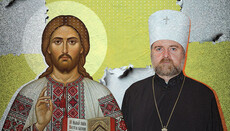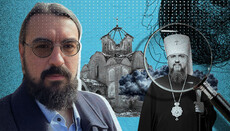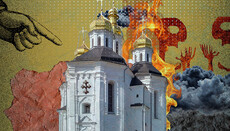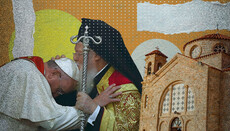Why the Albanian Church does not want to recognize the OCU
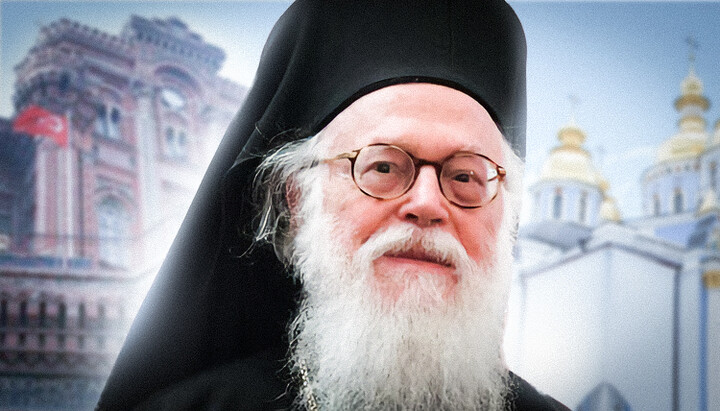
The Synod of the Albanian Church criticized the work of the Phanar theologian on the canonicity of “ordinations” of the OCU. Let's analyze the arguments on both sides.
The UOJ received a letter from the secretariat of the Holy Synod of the Albanian Church, in which the work of the General Secretary of the Synod of the Church of Constantinople, Archimandrite Gregory Frangakis, “On the healing of the ecclesiastical issue in Ukraine by the Mother Church of Constantinople (the issue of ordinations)” was commented in sufficient detail. The Albanian Church has presented convincing arguments against the main theses of Frangakis, coming to the conclusion that they do not correspond to reality. We propose once again to pay attention to the position of the Church of Albania and recall the main conclusions reached by its Holy Synod.
Historical digression
The issue of members of the OCU having no consecrations arose almost immediately after they received the Tomos of autocephaly in 2019. Several Local Churches declared at once that not only Epifaniy Dumenko, but his entire “episcopate” cannot claim canonicity. The main reason is that Filaret Denisenko could not perform consecrations being under anathema. At the same time, the “bishops” “ordained” by him make up almost the entire list of “bishops” in the OCU. “Sacred rites” performed by a person who is outside the church fold cannot be recognized as valid. This fact is so obvious that even Denisenko himself said that if he was under anathema, then neither Dumenko nor anyone else from the OCU is a bishop.
Even before the granting of the Tomos, it seemed to many that the problem of recognizing the schismatic “episcopate” of Ukraine, which the Phanar was facing, looked almost insoluble. The only way the Church offers in such a situation is the way of repentance. However, neither Filaret nor his children from among the "clergy" of the UOC-KP wanted to repent. After all, having repented, they would have admitted that all this time the Russian Church, which imposed an anathema on Filaret alongside other Local Churches that recognized its legitimacy, were right. Therefore, during lengthy negotiations, the Phanar and the Ukrainian schismatics were looking for such a “formula” that would allow the UOC-KP and UAOC to be accepted into canonical communion with the Church, bypassing the process of repentance. As a result, the scheme that the Phanar came up with, as we remember, had nothing to do with the canons of the Church:
- Filaret appealed to Patriarch Bartholomew with a request to reconsider the decision of the Russian Orthodox Church on his anathema;
- The Phanar repudiates its prior decision in spite of the fact that it recognized the validity of the imposed anathema until that time;
- Phanariots recognize the entire “episcopate” “ordained” by Filaret – retroactively.
What is curious: in addition to the completely anti-canonical decision to de-anathematize Filaret, the Phanariots recognized Makariy Maletich “in his existing rank”, who, before backsliding into the schism in 1989, was a simple priest of the Russian Orthodox Church. They decided to simply close their eyes to this fact, since it did not fit into any framework at all.
However, such decisions of the Phanar caused, to put it mildly, bewilderment among the Local Churches. They began to ask questions and demand clear answers from the Patriarchate of Constantinople. In this regard, the Phanariot theologians were tasked with somehow bringing a justification base under the decisions regarding the creation of the “holy church of Ukraine”. One of such attempts is the master's thesis of the General Secretary of the Synod of the Phanar, Archimandrite Gregory Frangakis "On the healing of the ecclesiastical issue in Ukraine by the Mother Church of Constantinople (the issue of ordinations)". It justifies the Phanar's decision to accept Ukrainian schismatics into communion with the Church without repentance.
It is worth recalling in this connection that it was the work of Frangakis that Metropolitan Isaiah of Tamasos (Church of Cyprus) referred to when he unexpectedly changed his irreconcilable position towards Dumenko and the OCU. Thus, the work of Frangakis looks like the main argument against those who do not agree to recognize the "consecrations" of the OCU. Therefore, it should be as truthful, justified and convincing as possible. However, in reality this is not the case.
Schisms in Albania and Ukraine: repentance and "recognition"
Frangakis' dissertation pays much attention to the granting of autocephaly to the Albanian Church in 1937. However, as the Albanian synodals write, “the information mentioned is inaccurate and indirectly misleading.”
In particular, Frangakis compares the fate of Filaret with the Albanian bishop Vissarion. Indeed, their life path is somewhat similar: both are schismatics, both proclaimed autocephaly, both were admitted by the Phanar, and both turned out to be unnecessary. The former – to the Synod of the Albanian Church, while the latter – to the "synod" of the OCU. Still, there is also a significant difference.
Bishop Vissarion, who was ordained in 1925 and in 1929 proclaimed himself the primate of the Albanian Church, did not ask for "recognition" from the Phanar, but asked for forgiveness, i.e. he repented. Filaret did not want to choose this path.
At the same time, the Holy Synod of Albania clearly indicates that the “consecrations” performed by the schismatic Vissarion were not recognized by the Patriarchate of Constantinople. In particular, on February 12, 1929, Vissarion “ordained” the “bishop” Agafangel, and already on February 25, the Phanar, in a Pastoral Message to the Albanian flock, announced the invalidity of Agafangel’s “consecration”.
“Consequently, Agafangel did not receive ordination from the defrocked, excommunicated and anathematized bishop, as was the case with Epifaniy, and he did not become the primate of the autocephalous Church,” concludes the Synod of the Albanian Orthodox Church.
There are no Sacraments outside the Church
Commenting on the “consecrations” of the excommunicated Filaret, the Albanian synodals emphasize that outside the Church the bishop “is deprived of all sacred grace, and his ordinations are invalid and inadmissible.” Phanar's thesis that an anathematized bishop retains within himself the possibility of serving as a priest was compared in the Albanian Church with the theory common for the Roman Catholic Church.
The point is that the sacrament of the priesthood with the RCC is just as “indelible” as the sacrament of baptism. Here is how the Catholic cardinal and head of the UGCC Lubomyr Huzar explained this: “The sacraments of baptism, chrismation and priesthood – having been received once – can never be lost: they can be illegal (if there is real guilt, which entailed the ecclesiastical ban of a certain clergyman), but nevertheless valid."
However, as the Synod of the Albanian Church rightly notes, “the theory of the permanence of the priesthood, accepted in the Catholic world, is not an argument for (recognizing) the transmission of grace and legitimacy of apostolic succession.” As an example, the synodals cite an electrical device that "does not transmit energy when disconnected from the current source." They lay a special emphasis on the following: “What never happened cannot become accomplished, valid, and legal by a simple administrative decision ... This is precisely what causes anxiety about the legality of the ordination of Epifaniy by Filaret.”
In other words, at the time of Dumenko’s “ordination”, Filaret was outside the Church, he was excommunicated and anathematized, which means that there was no “ordination” at all. How can you recognize or reinstate something that never happened?
One disease, one cure?
The Synod of the Albanian Church also disputes the thesis of Frangakis, according to which if schism is a disease, then it must always be treated in the same way. Since splits, like diseases, arise “due to various factors and circumstances”, therefore, according to the Albanian synodals, “like various diseases such as tuberculosis, malaria, cancer, etc.”, each individual case of both a split and a disease "requires a different approach to treatment".
This argument seems so obvious that its misunderstanding causes, to put it mildly, bewilderment. This bewilderment notably grows when, as a justification for their position (all schisms must be treated equally), the Phanariots cite the book of Bishop Basil of Smyrna, dedicated to the healing of the Melitian schism, “On the legality of the ordination of the clergy by a defrocked or schismatic bishop.”
The reason for writing this work was the break in relations between the Constantinople and Bulgarian Churches, which occurred in 1872. Then, as an example for reconciliation, the healing of the so-called Melitian schism was chosen. Its essence boils down to the fact that Bishop Melitios ordained priests in a foreign canonical territory, for which he was excommunicated from the Church. Later, Bishop Alexander of Alexandria received Melitios into communion. However, what is very important, Melitios at the same time gave Bishop Alexander a list of all the persons in priesthood he reportedly had in Egypt: bishops, presbyters and deacons. According to St. Athanasius the Great, “this was done so that when Melitios, having received freedom in the Church, he would not name many and every day, and whomever he wanted, falsely passing them off as having a holy dignity.”
Did the Phanar approach the Ukrainian schismatics in the same way as the Bishop of Alexandria did with the Melitians? The Holy Synod of the Albanian Church believes that it is not so, since the healing of the Melitian schism and the accession to the Church of priests invalidly ordained by Melitios included the following stages:
a) repentance
b) a special rite, involving the laying on of hands by the canonical bishop and prayer, in accordance with the expression of St. Athanasius the Great: “To accept into communion those who were ordained by Melitios and affirm by the mystical laying on of hands” (that is, by a simple laying on of hands with prayer, with the preservation of the former priestly ranks);
c) reconciliation between the parties to the conflict, as decided by the Ecumenical Council.
It is for this reason that the Church of Albania suggested that the Phanar should apply the same procedure, which resolved the Melitian schism, to the healing of the Ukrainian schism. That is, canonical communion with the “hierarchs” of the OCU can take place only if the latter repent, as well as in the case of a special rite with the laying on of hands, through the implementation of which the Church can consider their “ordinations” valid.
Naturally, both of these conditions presuppose the third one – reconciliation with the believers of the UOC, which can only take place if violence against them ceases (it is this requirement that comes first in the conditions that the Council of the UOC prescribed to start a dialogue with the OCU).
There are other theses in the text of the Synod of the Albanian Church that could be considered separately. For example, about the difference in the texts of the Tomos received by the Albanians in 1937 and the OCU in 2019. Anyway, as the synodals rightly point out, the main difference is the fact that peace settled in the Albanian Church after the arrival of the Tomos, which never happened to the Church in Ukraine.
The Lord said that a tree is known by its fruit. Today we see the fruits of the Tomos of the OCU in all their "beauty" – beaten people, burned and seized churches, expelled communities. Indeed, all the arguments of the Phanariotes are shattered by this last “knock-out” thesis of the Synod of the Albanian Church – there is no peace in Ukraine. This means that the Tomos for the "holy church of Ukraine" failed to justify its purpose.
So why is it needed?
